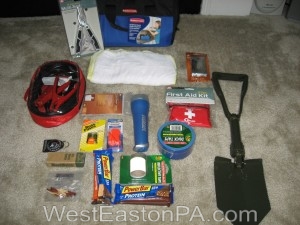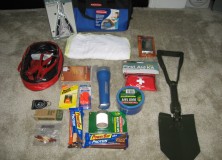 While many of us might travel to and from work within well populated areas, giving us the feeling that we have no need for a winter emergency kit in our vehicles, it is something that everyone should have in the event of an emergency. It isn’t a common snow event and short drives in them that can find us in trouble, but the unexpected circumstances that can result in a real life threatening situation. Being prepared for the unexpected may find you only uncomfortable, rather than requiring medical services, or a morgue.
While many of us might travel to and from work within well populated areas, giving us the feeling that we have no need for a winter emergency kit in our vehicles, it is something that everyone should have in the event of an emergency. It isn’t a common snow event and short drives in them that can find us in trouble, but the unexpected circumstances that can result in a real life threatening situation. Being prepared for the unexpected may find you only uncomfortable, rather than requiring medical services, or a morgue.
With the first relatively small snow event expected today I thought it might be time to discuss being prepared for a really bad storm that you and your vehicle might find yourself in.
It may be that the one day you decided to visit a long distance friend or relative finds you in unfamiliar territory. Low visibility from falling snow has you making a wrong turn down an isolated roadway. Miles later you realize you must have made a navigational error and decide to turn around. Whether your decision to travel that day was based on beating the predicted storm, or the predicted light snow has turned into something much worse, including single digit temperatures, you’re wishing you had put off your trip. You also aren’t pleased that you decided to wait until you arrived back home to fuel up again.
Your K-turn to get back to the main road puts you in a ditch you didn’t see because blowing snow filled it in, or maybe your car just decided right then to die on you. Possibly a flat tire has you stuck, because you haven’t bothered to check your spare for pressure in the last two years when you religiously checked the four others you drive on.
If you’re lucky, that 1/4 tank of gas will be enough to run the heater until you’re found by a passing vehicle.
If you’re unlucky, it isn’t enough. Your car isn’t running and you have no heat. You then realize that since you got on this road you hadn’t seen any other vehicles while you were driving down it.
You also realize that you are wearing only a light jacket. You had no plans on being outside during your visit, so your heavy parka remained home, as did your boots and gloves. You don’t have a wool cap and your toes inside your sneakers (or stylish lightweight boots) are already cold from the brief inspection of your car.
You don’t know where you are exactly, but wherever you are, your cell phone has no signal in this area and to make matters worse, the sun has gone down and you are in the dark with no light to be seen anywhere.
A road crew repairing electric lines finds your frozen body two days later less than 300 yards from the main road. You decided to walk out the way you came and it turned out to be a lot further than you thought it was. At the time it seemed the right decision because you were going to break teeth if they continued chattering while sitting in your car.
I agree that the above is the worst case scenario, but with the right items in a car emergency kit for winter breakdowns you might be uncomfortable, but your position won’t be life threatening no matter where you find yourself.
Whether stranded for 3 days, or 3 hours, a winter emergency kit for your vehicle is a simple and inexpensive way to ensure you and your family can survive the worst case scenario if caught in freezing weather. It can make a dangerous situation into a less than life-threatening adventure.
Gather up, or purchase the following items to create a Winter Severe Weather Travel Kit for each vehicle you own.
Vehicle Winter Emergency Kit
- a small folding shovel
- windshield scraper
- flashlight with extra batteries
- battery powered radio
- small compass
- water
- high calorie energy bars
- empty metal coffee can
- water-proof matches and 10 tea candles
- wool hat, wool socks
- snow boots
- gloves or mittens
- First aid kit
- pocket knife or box cutter
- Necessary medications
- blankets or sleeping bag
- tow chain or rope
- road salt, sand, or cat litter for traction
- booster cables
- 1 can of “Fix-a-Flat”
- emergency flares and reflectors
- fluorescent distress flag and whistle
- Cell phone adapter to plug into lighter
Kit tips:
- Reverse batteries in flashlight to avoid accidental switching and burnout.
- If possible, store items in the passenger compartment, should trunk jam or be frozen shut.
- Thermal “space” blankets saves kit area.
- Personal warmth items should be available for every family member.
- Personal medications (3 day supply) should be date marked to avoid expiration.
911 tips:
- If possible, call 911 on your cell phone. Provide your location, condition of everyone in the vehicle and the problem you’re experiencing.
- Follow instructions: you may be told to stay where you are until help arrives.
- Do not hang up until you know who you have spoken with and what will happen next.
- If you must leave the vehicle, write down your name, address, phone number and direction of travel. Place the piece of paper inside the front windshield for someone to see. Leaving your vehicle is a last resort.
Survival tips:
- Prepare your vehicle: Make sure you keep your gas tank at least half full.
- Be easy to find: Tell someone where you are going and the route you will take.
- If stuck: Tie a florescent flag (from your kit) on your antenna or hang it out the window. At night, keep your dome light on. Rescue crews can see a small glow at a distance. To reduce battery drain, use emergency flashers only if you hear approaching vehicles. If you’re with someone else, make sure at least one person is awake and keeping watch for help at all times.
- Stay in your vehicle: Walking in a storm can be very dangerous. You might become lost or exhausted. Your vehicle is a good shelter.
- Snuggle: Children on adult laps, adults side by side.
- Avoid Overexertion: Shoveling snow or pushing your car takes a lot of effort in storm conditions. Don’t risk a heart attack or injury. That work can also make you hot and sweaty. Wet clothing loses insulation value, making you susceptible to hypothermia.
- Fresh Air: It’s better to be cold and awake than comfortably warm and sleepy. Snow can plug your vehicle’s exhaust system and cause deadly carbon monoxide gas to enter your car. Only run the engine for 10 minutes an hour and make sure the exhaust pipe is free of snow. Keeping a window open a crack while running the engine is also a good idea.
- Burn candles in coffee can to create increased heat output if car heater is not an option.
- Don’t expect to be comfortable: You want to survive until you’re found.
Disclaimer: On January 4, 2016, the owner of WestEastonPA.com began serving on the West Easton Council following an election. Postings and all content found on this website are the opinions of Matthew A. Dees and may not necessarily represent the opinion of the governing body for The Borough of West Easton.







